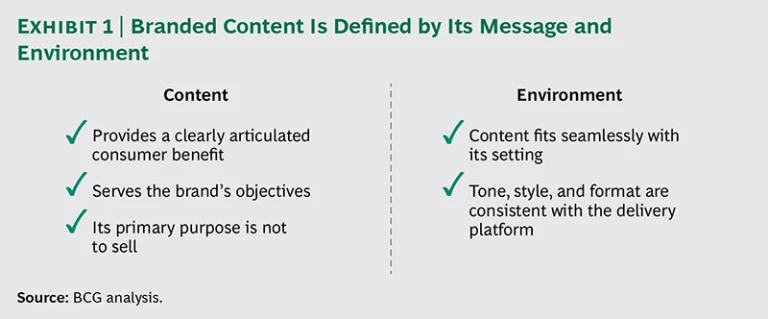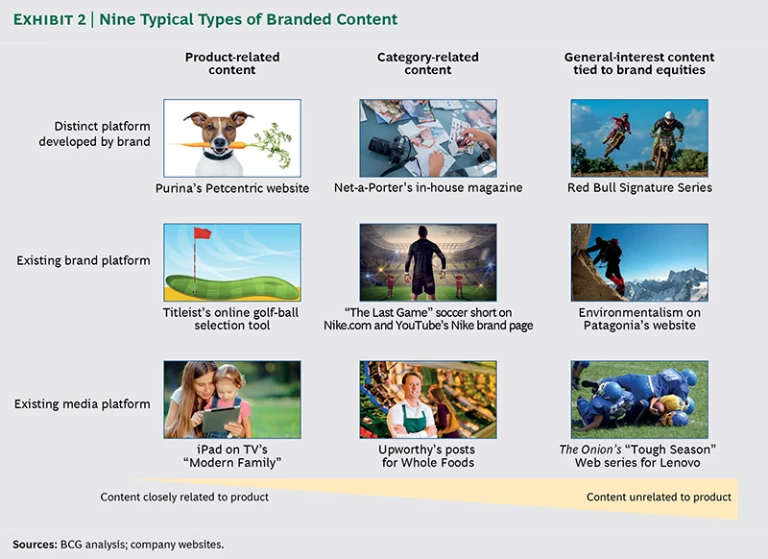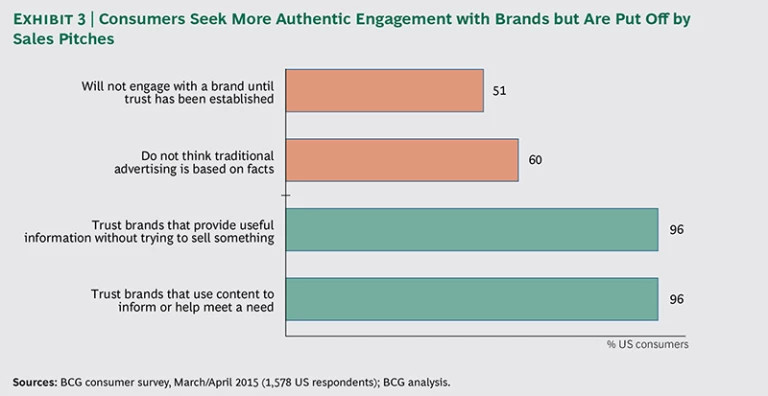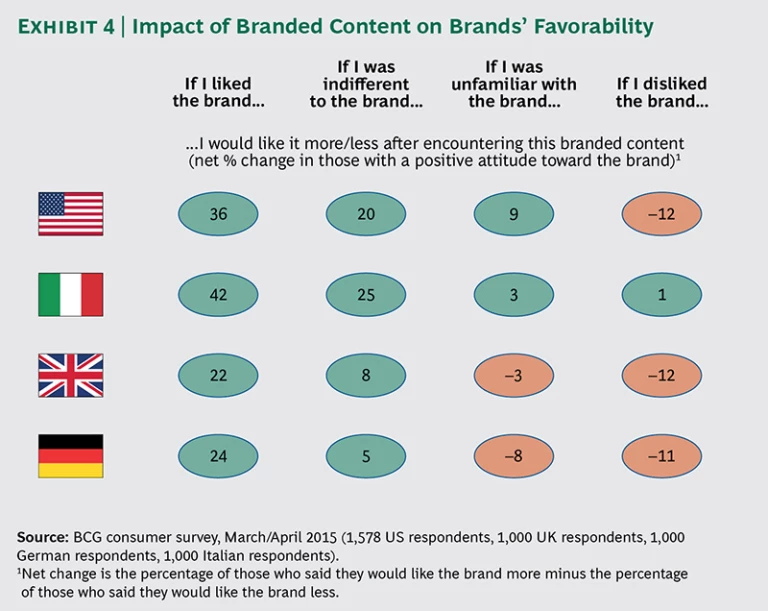It’s been a tool for marketers since at least the nineteenth century, but the twenty-first century may be when branded content comes into its own.
Powerful trends are undermining traditional marketing approaches and changing the longtime partnership between marketers and media companies. The media audience is becoming ever more fragmented. Consumer trust in advertising is
low. Digital and mobile innovations inject multiple new touch points between brands and consumers. Each industry is presented with a distinct set of challenges. While marketers look for new ways to engage with consumers, media companies need to replace lost revenue streams. Branded content is a big part of the answer for both.
But what is branded content today? There are almost as many definitions as there are examples. Ours is simply as follows: content that carries a consumer benefit, serves the brand, and is presented in an environment that consumers find authentic. The power of branded content is that it offers marketers the opportunity to build or deepen consumer relationships, and it provides media companies with new sources of revenue by helping brands achieve their objectives. Our research shows that consumers are very receptive. Not only do they want more interaction with brands, they both like and trust content created by brands and delivered on both brand and third-party platforms. The stronger a brand’s position with consumers, the stronger the positive reaction. Media company involvement further fortifies the impact.
There are conditions, of course. The content must provide a consumer benefit, and it must fit the environment in which it appears in a way that feels authentic to consumers. Numerous brands are already meeting these requirements—and more than a few are raising the bar—which is one reason why branded content is a big market that’s growing fast. We expect spending to increase by about 20 percent a year in the US, from about $10 billion in 2014 to $25 billion in 2019. Almost 70 percent of marketers say they will spend more on branded content this year than last.
As in many other young, fast-growing markets, a fragmented ecosystem is just starting to take root, with multiple players at each step of the value chain competing to serve the needs of both marketers and media companies. Consolidation will come and professionalism will increase. It’s too soon to pick winners and losers, but for marketers, it is not too early to choose partners and build relationships that will help brands play for the long term. For media companies, now is the right time to identify new businesses that could be sources of growth.
Not Your Father’s Advertorial
Many consumers and business executives, especially those in the baby-boom generation, often equate branded content with advertorials—content created by marketers that parades through the pages of newspapers and magazines as if it were the publication’s own editorial product. It’s a poor ploy; consumers are not so easily fooled.
The advent of digital and mobile technologies has given branded content a chance to reintroduce itself. Many marketers and some media companies have seized the opportunity—often with impressive results. “Branded” today therefore takes in a much wider spectrum of content, events, and experiences than ever before. There is no single, comprehensive definition.
Media companies tend to think of branded content first in terms of “native advertising,” which comprises multiple forms of paid-content marketing. The Interactive Advertising Bureau (IAB) defines six standard types of placement that it considers to be native advertising, but the organization also recognizes that this is a fast-growing market that is still in flux. “Native is in the eye of the beholder,” the IAB cautions.
Marketers talk about the importance of “content marketing”—which, according to author and marketer Seth Godin, “is the only marketing left”—but they have an easier time describing what it isn’t than what it is. “Lack of agreement has caused confusion in the marketplace,” the IAB says, distracting from “higher-level discussions such as effectiveness and disclosure.”
Defining Branded Content Today
The best branded content has always provided value to brand, publisher, and consumer, typically by demonstrating that the creator and the deliverer of the content (which sometimes are one and the same and sometimes are not) understand the user’s needs and want to address them. When branded content is done and presented well, consumers recognize its utility and are willing to accept it for what it is and can be—informative, fun, credible, and valuable.
John Deere’s magazine for farmers, The Furrow, first published in 1895, may be the longest-running extant example. The Furrow provides useful information in an entertaining format created expressly for the company’s customers; it is still read by some 2 million people around the world. More recent examples of branded content include “Whole Story,” the Whole Foods blog that often features content related to healthy eating and nutrition; Net-a-Porter’s Porter magazine, which is devoted to trends and developments in fashion; and Purina’s Petcentric site, which aggregates pet-related content on the Web. (Our own bcgperspectives website and mobile app is another instance of branded content, in a B2B rather than a B2C application.)
We believe that branded content is best defined from two perspectives. First, it combines the promotional purpose of traditional ads with the consumer’s experience of nonbrand-affiliated news, information, or entertainment. It provides a
consumer benefit in the service of a brand. Second, the content is consistent with its setting—that is, it fits with the medium or method that delivers it from both a creative and a contextual point of view. (See Exhibit 1.) Not all branded content is created equal, but all marketers that consider using it should seek to satisfy these criteria. They are the price of admission that will allow them to continue to play.
We see at least nine types of branded content at work today. These include three kinds of content—product-related, category-related, and general-interest content with ties to a particular brand’s attributes or the context in which it is used—delivered on three kinds of platforms: existing media (a TV show, for example), a brand’s own media (its website or social network page), or a platform created expressly for the content in question. (See Exhibit 2.)
These options are not mutually exclusive; some brands use all of them. The role of the Apple iPad on the TV sitcom “Modern Family” is an example of product-related content delivered on an existing media platform. Patagonia’s environmental videos speak to issues related to the company’s line of outdoor products and are shown on its own website. Net-a-Porter’s magazine is category-related content on a new platform designed to deliver it.
The Growing Importance of Branded Content
Media fragmentation is making it harder for brands to reach consumers and for media companies themselves to capture and retain a loyal audience. At the same time, consumer trust in traditional advertising is low. Our research shows that the three most trusted sources of information by consumers today are recommendations from family and friends, reviews by experts, and the opinions of other consumers. The least trusted sources are TV ads, brand and company e-mails, company posts on social media, and website ads.
Understanding this trust factor is critical. It’s not that consumers are unwilling to trust communications from brands; in fact, they want to believe them. But they are looking for substantive engagement that provides value to them; sales pitches turn them off. An astounding 96 percent of US consumers say they trust brands that provide useful information without trying to sell them something. A similar percentage say they trust brands that use content to inform them or help them meet a need. (See Exhibit 3.)
The digital revolution has not only given consumers much greater access to various sources of information, it has also changed and raised their expectations of all sources, whether they access them online or off. In addition, these developments have changed how consumers navigate the purchasing pathway. As a result, brands need to think differently about how they engage consumers at each step:
- Awareness. Brands need to provide consumers with content that introduces the brand in an authentic and engaging way.
- Consideration. Brands must show what they care about and demonstrate how they deliver value.
- Choose and Buy. Brands must create a personalized experience that informs and supports the purchase decision.
- Use and Share Views. Companies need to develop platforms for consumers to share their views and engage with the brand and with other consumers.
All of which points to more companies finding new ways to explore branded content.
Consumers to Brands and Media: “Give Us More”
In contrast to how they view advertising, consumers react positively to branded content in two critical ways: they generally like and trust the content they encounter, and they trust the media platforms on which it’s delivered.
In March and April 2015, BCG surveyed consumers in four countries—the United States, Germany, Italy, and the UK—on their views of branded content. We explored five product categories and asked about a wide range of media, including all major online and offline platforms.
Five findings stand out as having implications for both marketers and media companies.
Branded content is a powerful tool for many brands. Many brands can use branded content to create and deepen consumer engagement, as well as increase the likelihood of a purchase. While there are distinct national differences (see below), consumers in the four markets we surveyed generally like and trust a brand more—and are more likely to purchase it—after encountering branded content. Of particular significance for marketers, this finding applies to brands about which consumers previously had no clearly defined attitude.
Branded content magnifies existing perceptions. Marketers can use branded content to positive effect throughout the purchasing pathway, from building awareness through postpurchase reinforcement, but they should plan their campaigns with care. Branded content has a mostly positive impact on consumers’ view of a brand, but it also intensifies existing perceptions: those who are favorably disposed become more so, while unfavorable attitudes are reinforced.
Brands and media companies therefore need to carefully target the right consumers. (See Exhibit 4.) Polarizing brands should consider focusing their strategy on platforms that they own or control, rather than on third-party properties. Similarly, media companies may want to filter the content they accept or agree to participate in.
Media companies can play. Consumers do not believe that there must always be a rigid line between editorial and promotional material, and they are giving most media properties permission to carry branded content. But there are important distinctions by platform and market.
Consumers are more receptive to branded content on media-consumption platforms than on interactive platforms. Across all markets, they react negatively to branded content on gaming platforms, which have little history of advertising. Significant percentages of consumers in both Germany and the UK also react negatively to branded content in social media. But for most websites and print platforms, the traditional line between editorial and advertising is being blurred if not erased. The majority of consumers in all four markets have the same or a greater level of trust in media properties that carry branded content, but players in each media category must take into account consumers’ views of each type of platform.
Not all branded content works in the same way with everyone, everywhere. Age, national culture, brand category, brand affinity, and other factors come into play. Marketers need to determine in advance whom they want to talk to and how they can best engage their audience.
In the US, for example, almost all consumers have encountered branded content and appreciate the experience. Italian consumers are similarly enthusiastic. More than 30 percent of consumers in both countries are more likely to purchase a product after encountering branded content. The impact of branded content on consumers in the UK and Germany, while still positive, is more muted. Global marketers, in particular, should take note that branded content, like other forms of marketing, needs to be adapted to local realities.
Brands reaching out to younger consumers should embrace branded content quickly and fully, as these consumers are the most receptive that marketers will find. In the US, for example, Millennials (ages 18 to 34) show a net increase of almost 30 percent in both affinity for and trust in a brand after experiencing branded content. On the other hand, brands that appeal to older consumers, and media properties whose audience is older, should be very conservative in their branded-content strategies. So-called silvers (ages 65 to 74) in the US show a decrease of almost 15 percent in affinity and trust after encountering branded content—and a similar drop in affinity for media companies carrying the content. However, this is the only age demographic that evidences significant negative perceptions of branded content.
Among the brand categories we tested (automobiles, electronics and technology, foods and beverages, luxury goods, and personal-care products), branded content associated with high-end and lifestyle categories resonates most strongly with consumers. This is true both for the brands themselves and for the media companies that deliver the content. High-end products generally require more consideration before a purchase is made, they are more aspirational, and they tend to involve a stronger emotional connection with the consumer, all of which play to the strengths of branded content. Brands with a high degree of consumer affinity should pursue aggressive branded-content strategies, especially in countries where consumers show high receptivity, such as the US and Italy.
Credibility is critical—and style counts. For branded content to be accepted, marketers and media companies need to be honest and sincere. Strong majorities of consumers in all markets put credibility at the top of the list of must-haves for branded content. Tone and style are also important (just as they are with nonbranded editorial or entertainment content). Humor and thought-provoking ideas help promote engagement. Readers want attractive design and layout. And there’s a strong desire in all markets for marketers and media companies to keep the content brief.
A Big Opportunity for Media Companies
Media companies are not only being invited to play a role in the future of branded content, they are also being offered a big and multifaceted business opportunity if they do. At the very least, media companies need to meet the growing demand of consumers and advertisers by developing a core offering that marries two capabilities: integrating native ads seamlessly into consumers’ interactions with media and working with brands to develop creative content for distribution through media platforms. A number of major media companies, from CNN to the New York Times to Condé Nast, have already started to set up branded-content capabilities, some complementing their editorial expertise with people hired from advertising and other marketing companies. We also see potentially attractive opportunities to build adjacent businesses in three areas: full-service branded-content offerings, native-ad sales on media companies’ private exchanges, and content management services for marketers.
Developing these capabilities will require a transformation in the way most media companies do business. Many are not prepared to deliver their core offering effectively, much less build ancillary businesses. As the nascent ecosystem that has sprung up around branded content matures and consolidates, media companies have an opportunity to bolster their capabilities through acquisitions. Google’s 2008 purchase of DoubleClick is an example—from a previous wave of marketing technology innovation—of an incumbent player moving quickly to establish a strong position in an emerging value chain.
The Core Offering
Marketers are already accessing all manner of outside resources to help with their branded-content efforts, including both traditional ad agencies and new players, especially companies with expertise in digital content. Media companies have a built-in advantage over all these intermediaries: their involvement in branded-content creation raises the level of consumer engagement by some 17 percent.
The biggest challenge for media companies is likely to be developing a clear delineation between editorial and branded content, while at the same time ensuring consistency between the two. Getting this balance right is critical because of the importance of credibility. Companies with a history of enforcing a strong division between editorial and promotional content, in particular, could face significant organizational and cultural hurdles, especially if they need to reassign talent across this longstanding “church-state” barrier.
At a macro level, media companies will need to transform their business models and organizations in four key ways as the market continues to shift from a predominantly advertising-driven model to one in which branded content leads. They will need to move from their current models in the following ways:
- Developing customized opportunities for audience engagement, rather than selling standard ad units, such as 30-second spots and banner ads
- Producing short- and long-form content that appeals to audiences on behalf of brands, rather than placing advertisements created by a brand or its advertising agency
- Cultivating creative-development teams to produce branded content, rather than managing standalone editorial teams separate from ad sales or publishing
- Developing sales executives who market custom-content services, rather than deploying advertising sales teams that sell media time, space, or computer-screen real estate
Especially for traditional publishers and electronic-media players, making this transformation is likely to be an organization-wide undertaking that takes several years. Media companies will need to rethink their recruiting and training of sales staff. They will also need to integrate branded-content sales teams with existing staff responsible for customer relationships. It may be more expedient and productive to acquire some capabilities rather than try to build them. Because of the speed at which the market is evolving, those that move most quickly will have an advantage.
Ancillary Opportunities
The transition to an online world has been tough for many traditional media companies. Print publishers have seen ad revenue streams all but evaporate, and TV audiences have fragmented. Thanks to branded content, however, traditional media companies are looking at the potential for major new revenue streams—if they act quickly. Here are three of the most promising opportunities.
Full-Service Branded-Content Offerings. With their creative and content capabilities and their strong relationships with consumers, many traditional media companies are in a terrific position to go beyond native ads and content production and offer a full, end-to-end branded-content service to marketers. This includes content strategy and planning (translating brand strategy into specific creative concepts); content optimization (analytics that measure the results of a branded-content campaign and provide recommendations to improve efficacy); and new branded-content production services and tools (such as social-media services, sourcing of creative talent, and creation of content for the marketer’s own platforms).
The market for all these services is growing quickly and, as we have seen, is currently disjointed, with multiple players operating in various niches but very few
(if any) one-stop shops. Moreover, the traditional ad-agency oligarchy is much less entrenched in branded-content services, and media companies have a unique combination of access to creative talent, credibility with consumers, ownership of audience data, and consumer respect. Most also have strong relationships with advertisers on which to build.
Native-Ad Sales on Private Exchanges. Programmatic buying is already a $9 billion business globally and is growing at 30 percent a year. It is expected to be a $33 billion market by 2019, as marketers, increasingly driven by performance metrics, pursue real-time bidding and the other advantages that programmatic buying offers. This is also still a very young market, with no clear dominant players yet. As with full-service offerings, traditional media companies have the opportunity to differentiate themselves by combining existing and emerging capabilities. By inviting individual advertisers and agencies to bid on high-quality pools of inventory on private exchanges, media companies can combine the efficiencies of programmatic sales with the quality and efficacy of native-ad placements. They can also control pricing and inventory for their own exchanges and maintain direct advertiser relationships.
Media companies can take the offering one step further. Few (if any) players today are integrating recommendation capabilities through Web widget add-ons or “other content you may like” features. By integrating recommendation capabilities, media companies can improve the efficacy of private exchanges and the differentiation among them.
Additional Content Management Services for Marketers. Marketers face any number of needs as they build their branded-content programs, including the following:
- Capturing the growing volume of their own, third-party, and user-generated content
- Efficiently adapting content for new devices
- Developing a user-friendly platform to serve as a single, searchable access point for content teams across all of a brand’s owned content
- Integrating content data with user data for better ad targeting
- Evaluating the quality of user-generated content
- Reducing manual requirements for updating content across platforms
- Personalizing their Web presence and consumer communications (custom landing-page content, recommendations, and e-mail offers, for example)
Serving these needs was already a $7 billion market in 2014, a figure that is expected to grow by about 13 percent a year over the next five years. While there are a number of strong competitors, and switching costs are high for brands because of the complicated deployment of Web content management systems, we believe there is room for a few media companies to develop solutions. In the same way that Amazon realized it could lend its data management technology and skills to other companies and proceeded to build a multibillion-dollar cloud-based service business, a few ambitious media companies have the opportunity to leverage their content management capabilities into a new revenue stream. In addition to the requisite technology and skills, they have important built-in advantages, including existing relationships with marketers and a strong sales position with their current brand partners.
Build or Buy—But Quickly
In an evolving ecosystem that will inevitably undergo rationalization and consolidation, early movers may be able to establish positions that will be difficult for others to assail. Developing the capabilities necessary to offer both core and ancillary services will require skills and technologies that most media companies do not now have. These can be developed or built internally, but some companies may find it easier, less expensive, and quicker to buy what they need. The ecosystem has many players, and new entrants offering innovative services start up almost every day—whether it’s content discovery from Taboola, recommendations from Outbrain, native exchanges from Sharethrough, content creation from Contently, or content marketing from NewsCred. The best technologies and the people behind them will be targeted early. Those media companies that wait for the market to shake out may find themselves on the outside looking in—in just a few years time.
An Imperative for Brands
Brands need branded content. They need it today to reach through the clutter and engage consumers; even more, they will need it to stay relevant tomorrow as competitors ramp up their own branded-content programs. Already we are seeing marketers as varied as Nike, Titleist, Red Bull, and Lenovo set the branded-content bar high in their respective categories. They are unlikely to rest on their laurels.
There’s nothing stopping other brands from catching up and overtaking. And plenty of help is available. The expanding ecosystem of creative, distribution, publishing, and measurement companies continues to bring more players into the market, with more specialized skills and services. Traditional marketing agencies are active, but new entrants with purpose-built capabilities and technology have also made deep inroads.
Smart marketers will recognize that the goal is not to kick out a few clever videos or ramp up an interactive campaign that generates buzz in the trade press. Brands need to build a capability that can perform over the long term, integrated with and supporting the broader marketing strategy. For this reason, marketers should learn to walk before they try to run.
The Must-Haves
We recommend that marketers follow these steps up the branded-content sophistication curve.
- Clearly define the branded-content goals and strategy. A brand’s desired position with consumers and the goals of its marketing at each stage of the purchasing pathway should inform creative specifications and media strategy. A 2015 study found that only 27 percent of brands have a documented branded-content strategy.
- Centralize creative expertise in a dedicated unit. Branded-content campaigns will differ from a company’s other marketing communications in both form and content. Centralization of content development expertise improves efficiency and quality and facilitates efficient adaptation of content across delivery channels. The same study showed that only 45 percent of brands have dedicated content units.
- Allow editors to drive content development. Traditional content creators, rather than brand marketers and managers, are best equipped to meet consumers’ desire for authenticity.
- Centralize media buying. Marketers should manage traditional and branded-content media purchases jointly with a centralized team to maximize negotiating power and scale efficiencies.
- Measure and track ROI. The importance of measuring success against the right KPIs and having access to the necessary analytics and measurement tools will rise as branded-content budgets increase. Research indicates that only 23 percent of brands today successfully track ROI for branded content. (See “Setting Goals, Demonstrating Impact.”)
- Invest in content storage and management tools. The growing volume of content generates operational complexity. Technology solutions can reduce the time spent on file management and help deploy content efficiently.
Setting Goals, Demonstrating Impact
Marketing departments often struggle to demonstrate the impact of content marketing. Research shows that less than a quarter of marketers in North America believe they are even barely successful at demonstrating content marketing’s impact. There are multiple reasons. Some of the most commonly cited: too many metrics to track, lack of skilled staff, no adequate measurement tools, and low levels of trust in the data itself. One inevitable result is corporate reluctance to devote more money to content marketing.
To measure branded content more effectively, marketers need to augment their existing marketing measurement methods with new thinking, upgraded tools, and a stronger appreciation for what good measurement goals and progress monitoring can achieve. Here are seven steps that any company pursuing a branded-content strategy should consider.
- Adopt a measurement mind-set. Ensure that the content-marketing team is ready, willing, and able to embrace accountability. Set self-enforcing guardrails that prevent investments in content marketing without an accompanying plan to measure a campaign’s effectiveness.
- Specify the overall business goal at the outset. Unlike most traditional advertising, branded content plays a role beyond driving volume, sales, and profits. Other, nonfinancial outcomes, such as augmenting the customer experience or improving brand health, need to be defined and communicated before execution so everyone knows what the criteria are for success.
- Track the right metrics. Based on the business goals, generate a long list of raw metrics that can be tracked. Then prune the list to include those metrics and KPIs that best reflect performance against the business goals.
- Expand the analytical toolkit to link branded-content metrics to business goals. There are many measurement tools available to marketers today, including on-site A/B testing, marketing-mix models, digital attribution models, discrete-choice models, and customer analytics. Existing tools need to be adapted to measure the impact of branded content alongside other marketing efforts.
- Speak a “common language.” Branded content’s contribution to the overall marketing strategy has to be viewed on an equal basis with the measured impact of other marketing efforts. Marketers need to agree on common metrics and calculations to enable apples-to-apples comparisons between marketing investments.
- Find the root causes of success or failure. If something is not performing as expected, dig deep to understand why by analyzing creative content, messaging, platforms, reach, execution, and costs. Jettison what’s not working early on.
- Turn insights into action. A company’s content-marketing success will depend on how well management is able to assess what worked and what didn’t and why—and to translate these insights into action. Content-marketing metrics and measurement outcomes should form an integral part of the budget decision-making process. Set budgets based on desired impact. Make campaign alterations in real time. Learn from what doesn’t work; isolate areas for improvement to achieve greater impact next time.
Building a Full Media-Support Capability
Some brands that experience success with branded content may ultimately aspire to build their own standalone media business, allowing them to leverage brand loyalty with consumers and even create an additional revenue stream. These will be brands with widespread consumer followings and favorability; it is a strategy that can backfire for more controversial or polarizing brands, since branded content amplifies existing perceptions and reactions.
Red Bull Media House provides one model. The company’s multiformat ecosystem includes content created expressly for multiple platforms—film, TV, the Web, mobile apps, music, magazines, and games. The results are hard to ignore. More than 500,000 unique visitors go to redbull.com every day. Red Bulletin magazine has built a global circulation of more than 3 million readers a month. Some 72 million people follow the brand on social media. Individual content initiatives reach millions: the trailer for the documentary The Art of Flight recorded some 10 million views across various platforms. Red Bull generates revenue through ad sales, content licensing to other media purveyors, and direct sales to consumers of content such as books and DVDs.
Branded content is big business that will get much bigger. For marketers and media companies it represents both a necessity and an opportunity.
For marketers, the challenge is more complex. What content do they create? How do they create it? Which delivery platforms do they use, and in what combination? How does branded content fit within their broader marketing strategy?
The challenge for media companies is subtler—but the stakes are no less high. Media companies have a clear set of assets they can extend to brands, including, critically, creative capabilities and audience trust. These advantages, which many media companies have spent decades building, can help brands meet their branded-content objectives and give media players an opportunity to profit in the process. But they must be treated with care, as consumer trust is fragile and can be quickly eroded.
Experimentation and a test-and-learn approach will be key. For those that have yet to wade into the branded-content waters, the time to start is now—while consumers are still curious, the marketplace is taking shape, and there is room for anyone who wants to play.
Acknowledgments
The authors are grateful to Derick Stace-Naughton and Thomas Recchione for their valuable assistance in the preparation of this report. They also thank David Duffy for writing assistance and Katherine Andrews, Gary Callahan, Kim Friedman, Abby Garland, Gina Goldstein, Amanda Provost, and Sara Strassenreiter for editing, design, production, and distribution.












